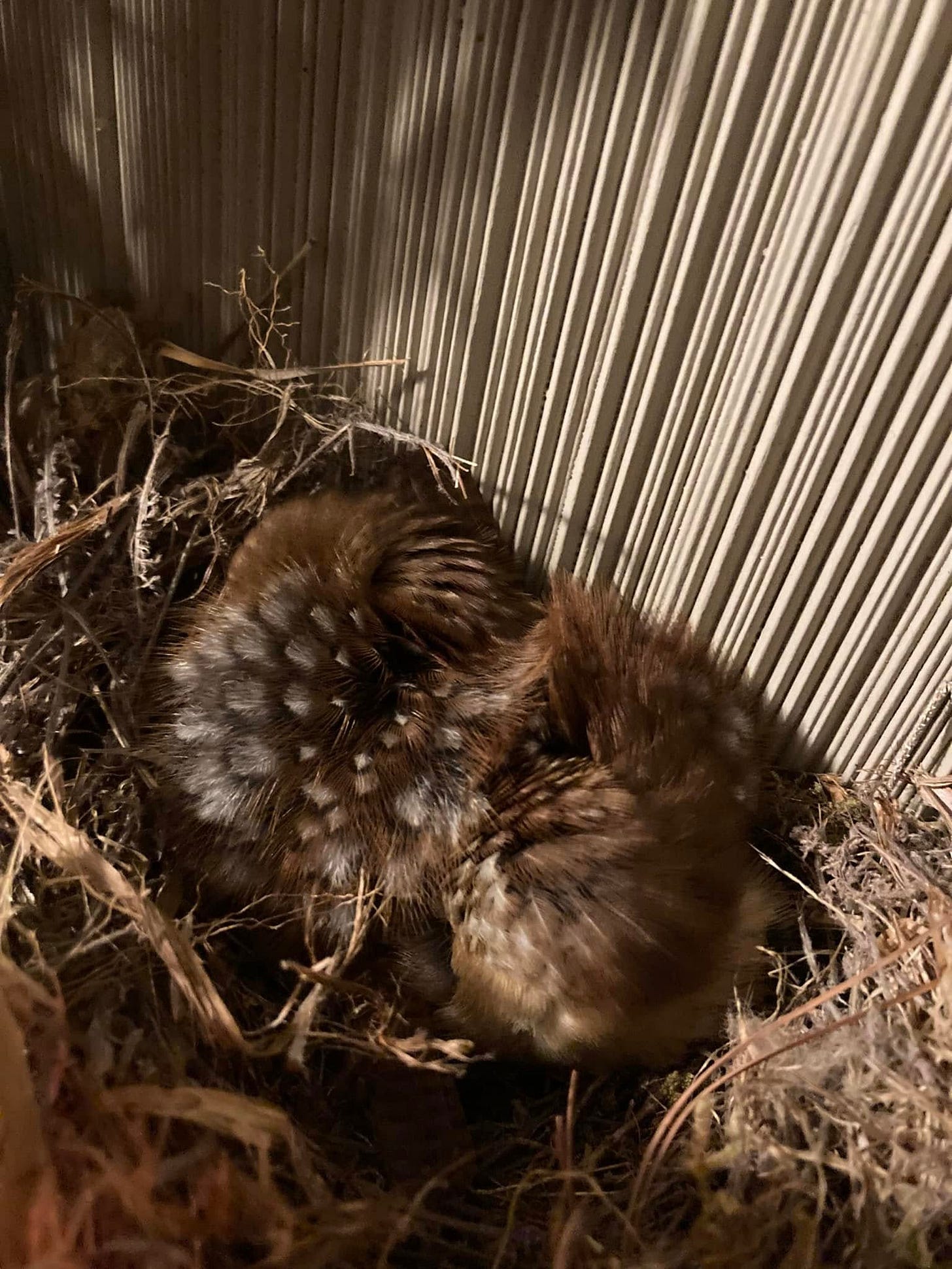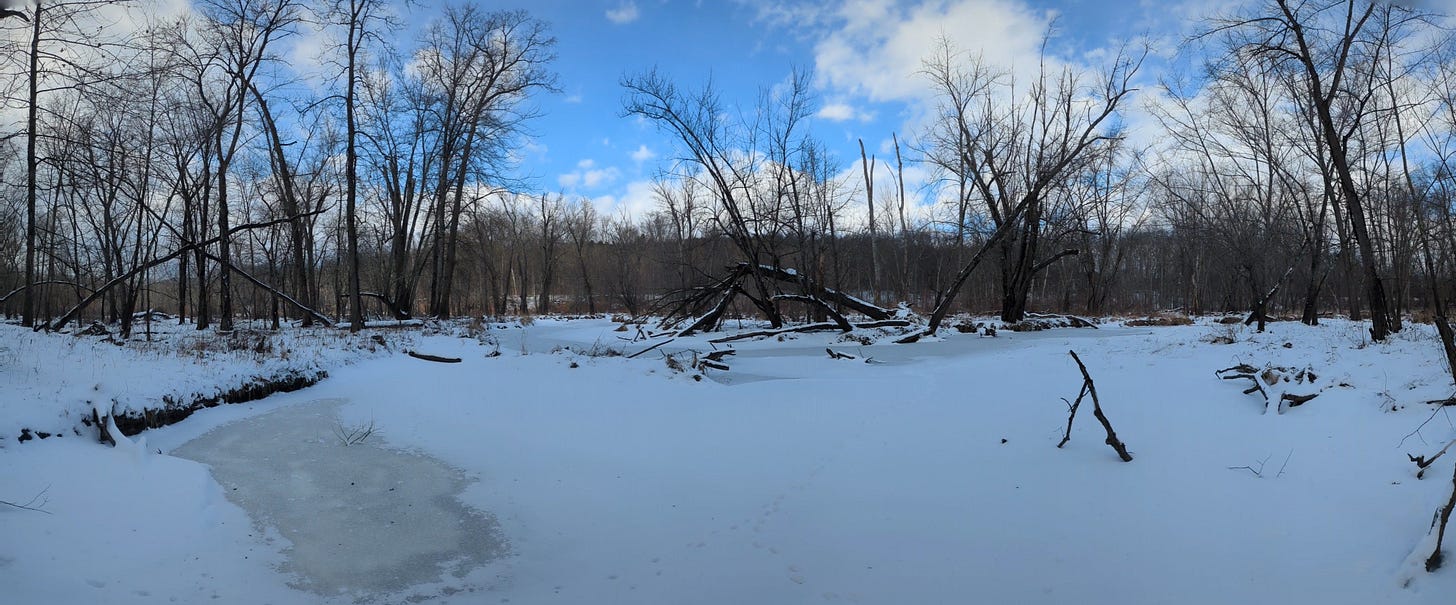Birding Western Mass: Ice Bushwhacks, Survival
Thoughts on Birding from the Quabbin to the Berkshires
Study Up
You didn’t ask for flock season and flock season didn’t ask for you but it’s what you’ve got and it’s what I’ve got and that’s all there is to it.
Winter demands that birds establish fellowship in the interest of finding food. (Another prevalent hypothesis is that they do it to share vigilance, but experiments and observation so far have not borne that out.) Analyses of mixed-species woodland flock behavior even show that they’re more likely to form where food choices are worse. In these little flocks, birds are more likely to employ specialty behaviors to find their foods, such as foraging at distinct heights or for particular foods.
As I write this, house sparrows and juncos are tolerating each other in my weed patch. The morning started with juncos coming for their pre-dawn seed scatter, but as they day progresses, the superabundance where I toss handfuls of nyjer and safflower makes for waves of songbirds willing to deal with each other or traveling in flocks of variety.
So I have spent weeks looking for flocks. I’ve had good luck. Also, winter allows me to do it in new ways.
Open Water.
In recent issues, I have considered where to find ducks now in two lists. Finding ducks on the water is about the same as finding gulls here. When I’ve lived elsewhere, the landfills have been the place to look for gulls in winter, but in Western Massachusetts, that’s apparently not the case.
Where ducks and gulls are, there are also eagles.
Someone I met birding the Holyoke Dam suggested the water just upstream of the Holyoke Dinosaur Footprints for goldeneyes. There’s a bit of water that runs deep enough with enough movement to keep it open longer than elsewhere. The ducks were there — common goldeneyes, the males with that iridescent sharp moss-green that makes you gasp. (Mallards are pretty too, but you see them at duck ponds. Be real: Rarity and seasonality make things prettier.) They were in a flock working upstream like it was a treadmill and they were going to beat it.
Birds like these are easy to see as heroes. (I read that there’s a major flock of commons and a Barrow’s at the Sunderland cemetery on the river.)
Gulls are in the same places, and therefore so are the relevant birds of prey, which this time of year is mostly eagles and peregrines on water.
Outside the scope of this newsletter is all of Connecticut. I did slip down there yesterday to have lunch with a friend and walk the beach at Hammonassett State Park. It did me good to have some easy views of sea ducks. When I could get the sun behind me I could even see the colors on the scaups’ heads.
Weeds.
At the Great Pond, which also sometimes has some open water even in hard cold days, there’s a substantial amount of weedy land to the east of the pond as you walk along it. (That’s the side that does not have the bluff.) I birded that for the CBC and this year there’s plenty of cover for mousy sparrows to stay safe and glean seeds. I had a fox sparrow there a few weeks ago (thank you, sparrow, for being in the glass with a song sparrow for comparison).
Feeders.
If you can get out for a walk just now you might see fewer birds on the whole walk than you would see at a feeder in the same time. You may not have the opportunity to have a feeder. If that’s the case, consider visiting nature preserves with feeders, such as Arcadia or Hitchcock.
Overflight
Weather intensifies the strangeness of the world outside the human day and night. While we continue to (most of us here in the U.S. with time to bird) to live in a world where daily survival is not in question, birds are living moment to moment. Below is a picture my friend Carolyn sent me. (You should definitely sub to Carolyn’s newsletter. She is a writer and a writing teacher and stans for all of the good things related to these matters.)
This is two (?) Carolina wrens who have taken shelter in Carolyn’s wreath. Such wren sleep is so well-documented that there is a subreddit devoted to such images. (A subreddit is a category of posts on reddit, an Internet land of conversation similar to what we used to call forums, and before that, Usenet, and before that, The Well, and before that, well, forums.)
Winter is keenly challenging. Lots of birds don’t survive the cold winters here.
The daily riddle of how to get food, stay warm, use as little of the food as possible and get to spring demands a great deal of birds.
I rarely see birds as cute or whimsical. Birds weren’t something outside my experience when I was little. They weren’t characters in fiction; they have always been wild animals composed of the evidence of their canny endurance of a brutal realm.
I mean, but then, there’s fluffy wrens.
In the winter all bets are off. The miracle of a species’ confronting the challenge of the cold and the tapering off of food resources (no weedy field stays full of seeds forever) to make for a more sympathetic experience. When I’m cold, they’re in a kind of cold I can’t imagine. Their sleep is peril. A Cooper’s hawk just burst through the doves under our feeder; they catapulted into the woods. The hawk was foiled; the doves are threatened.
The sympathy I feel turns to empathy and while the pathetic fallacy is always a threat it is also a benediction. Survival can require transformation — some birds even add cognition and alter their digestion for the hard winter months — but there is hope.
Birdscape
I walked Bachelor Brook on a very cold Sunday. I parked at the South Hadley Community Garden and walked in a little, then cut to the right (meaning north) across the ravines to get to a creek. The woods away from paths are more accessible in winter, both because you can walk on the snow and I think you can feel more confident that your exiting the path is not causing damage to any fragile vegetation. (Although in truth Bachelor Brook feels quite rugged and not particularly fragile, I’m sure I don’t know what I should about any areas of sensitivity.)
I followed the creek down to the brook where it snakes through marsh toward the river. I wore spikes on my boots (I had on nanospikes, which did poorly because the last person I loaned them to smashed them flat on rocks, but I didn’t know that until I got to the ice).
I walked the brook through its meanders toward the river. When my mother read a memoir by someone in the 1970s that included the ability to skate a creek in winter to get the mail, she talked about it for a while — imagining the back road for travel. I remember such stories, too, of icy rivers serving as flattish methods of travel through wildernesses.
The winter creeks here serve this purpose for me. With (unflattened when possible) spikes on, I walk stretches of flat paths that didn’t exist a month ago and will disappear in another month — some will be kayakable, but many won’t. (I can’t skate well and the ice often has snow on it anyway.)
On Bachelor Brook, I saw song sparrows work delicate hummocks of grass for food. There were coyote tracks, including a place where the coyote had urinated and then kicked behind it to leave its canine mark for others to see. There was a place where coyotes met and skirmished or celebrated (or perhaps that’s both).
There was a swamp sparrow. I heard it first, confirmed it with Merlin, then saw it. It’s surviving and if it survives long enough it will be here when spring comes, first on a choice swamp territory. (Or it will head north but wit a head start to reach its destination soonest.)
Bird Books and Whistles
We’re watching the Nova episode on early birds. I bet you’d like it too.





Excellent winter thoughts. So glad you got down to Hammo! I love it there. A kind birder with a scope helped me get like six lifers a few weeks back.